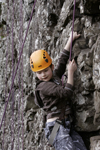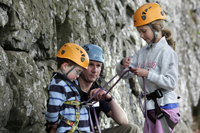- Details
- Written by: David
Looking down from his position six metres above the ground, six-year-old Rowan cracks a broad smile and briefly lets go of his grip with one hand to give a thumbs-up sign. After seven minutes of determined climbing, some highly audible huffing and puffing and a fair amount of scrabbling, the youngster’s determination to reach the top of a tricky crag face located somewhere in the wilds of Perthshire has paid off.
‘He’s really good at climbing already, isn’t he? But surely it’s my turn now?’
It appears that his friend is almost as pleased with Rowan’s efforts. ‘Awesome!,’ nine-year-old Havana exclaims, gazing upwards. ‘He’s really good at climbing already, isn’t he? But surely it’s my turn now? And so the second that Rowan returns to firm ground following a smooth abseil off the summit, Havana begins to busy herself with the task of tying a rope into her harness and belay system.For Rowan, Havana (my daughter) and Rowan’s eight-year-old brother, Ally, the Outdoor Climber Course, which is part of a climbing activity programme organised by the Edinburgh International Climbing Arena (EICA), provides their first experience of climbing on natural rock.
Coached by an informative and child-friendly instructor, Glenn Gordon, during a morning session the young climbing trio learns how to put on a harness, and how to safely configure the rope, harness and belay system via an anchor at the top of the crag. They have also been shown where to stand while other people are climbing, and how to tackle a rock climbing route. In just a couple of hours the youngsters have made around ten ascents of increasingly challenging routes along a low but long ‘sport climbing’ crag called Benny Beg, near Crieff at the southern end of the Highlands.
According to Glenn, children are quick learners and make natural climbers. ‘Most kids instinctively want to climb up and over things, and they have this in-built enthusiasm, so the activity of climbing is perfect for them,’ he says. ‘As soon as you show them a few tips about where to put their feet and hands, and a bit about body positioning, they’re off.’
Having thoroughly checked Havana’s rope and harness – ‘All correct, but just needs to be a bit tighter. Well done!’ enthuses Glenn – the instructor then encourages her to find the first few foot- and handholds for herself. Naturally more timid than Rowan, Havana is keen to discover nooks and crannies in the hard, grey rock that offer secure places to tuck in the toes of her tight-fitting climbing shoes or hold onto with her bare fingertips. As she makes a cautious but smooth ascent, Glenn suggests where Havana might try for a handhold. ‘Just to the right and slightly up above your right hand,’ he hints. ‘Yes, that wee lump of rock, that should be big enough to take a few fingers.’ As Havana ascends, he pulls in the slack rope using the belay mechanism. The secure system means that, should Havana come off the rock, her fall would be quickly broken. But falling is not her intention. Nor, it seems, is reaching the top – this time. ‘My legs feel like jelly,’ she hollers back down to Glenn. ‘Can I come down and try again later?’ Lowering her smoothly to the ground from almost three-quarters of the way up the rock face, Glenn praises her for ‘trying really hard’.
Climbing does not have to be about reaching the top, nor being competitive. ‘The great thing about climbing is that it offers all kinds of goals for all kinds of people,’ Glenn says. ‘For some kids. simply putting on the harness and getting off the ground feels like a really big achievement. Others aren’t happy unless they’ve ‘topped out’. But either way, there is a lot to be gained for children, both mentally and physically.’ In fact, many experts believe that climbing offers an ideal ‘alternative’ fitness activity for youngsters. According to Kevin Howett, development officer at The Mountaineering Council of Scotland, climbing appeals to children who aren’t so keen on traditional sports, such as football or hockey.
Kevin says: ‘There are no set rules for climbing – other than safety guidelines – and participants can move and progress at their own pace without needing to form part of a team. Many children love the freedom that climbing brings.’ With practice, climbers become agile, strong and toned. Howett points out: ‘To climb well, you need a combination of strength, flexibility, balance and movement techniques. Climbing is a great all-round fitness activity.’
Many climbers also enjoy the cerebral challenge of finding – or ‘solving’ – a sequence of moves to reach the top of a rock face. And, typically, there is a great camaraderie among climbers. Glenn says: ‘Climbing is a very sociable sport. Yes, you are often making the climb yourself, but you will also be relying on your climbing partner to belay you. ‘At other times there will be groups of climbers offering hints and guidance to each other about routes.’
 Certainly, the three young Outdoor Climbers I’m with seem keen to support each other – although at times they are a little over-eager. With Ally now set to make an attempt on another route at the Benny Beg crags, both Rowan and Havana offer their advice. ‘Look, there are two sticky-out bits over there for your feet,’ points out the ever helpful Havana. ‘And there is a hole up there for your fingers,’ offers Rowan. ‘No – I think that crack to the left looks better for his hands,’ retorts Havana.
Certainly, the three young Outdoor Climbers I’m with seem keen to support each other – although at times they are a little over-eager. With Ally now set to make an attempt on another route at the Benny Beg crags, both Rowan and Havana offer their advice. ‘Look, there are two sticky-out bits over there for your feet,’ points out the ever helpful Havana. ‘And there is a hole up there for your fingers,’ offers Rowan. ‘No – I think that crack to the left looks better for his hands,’ retorts Havana.
But Ally has his own ideas. Starting with a small jump, he leaps up and onto the rock, grabbing a chunk of it with both hands before swinging his right foot onto a thin ledge. ‘Cool, Ally, you look like a monkey!’ says his brother. ‘I think monkeys make great climbers,’ says Glenn, laughing.
Great Scottish climbs for beginners
While most new climbers come to the sport in Scotland via a host of stunning indoor centres, the country is world-renowned for its fantastic outdoors climbing playground.
Climbing ranges from beginner-friendly crags to one of the world’s hardest traditional rock climbs, the ‘Rhapsody’ E11 near Dumbarton, which was completed by top Scots climber Dave Macleod in 2006.
For those starting out in outdoor climbing, here is a round-up of some of the best sites suggested by the Mountaineering Council of Scotland:
Starter sport crags: All have easy access and in-situ bolt protection and lower-offs
- Benny Beg, Crieff: 10m high; a vertical south-facing escarpment near a café with closely spaced bolts especially for children
- Creag Beag, Golspie: 12m high; vertical conglomerate near the sea with a range of difficulty levels
- Grass Crag, Gairloch: 15m high; climbing on ancient Lewisian gneiss
- Ley Quarry, Forfar: 15m high
- Kirrie Hill, Kirriemuir: 15m high
- Cambus O’May, Deeside: 15m high; granite; stunning woodland location which faces south with slabby routes
Starter trad crags:These crags all offer easily accessible climbing, with easy ways down from the top, and contain climbs that have good natural protection. It is highly advisable to visit them only with a guide or instructor.
- The Wangie and Craigmore, Glasgow: 10m to 15m-high escarpments with cracks and corners and some bouldering along
the base. - Auchinstarry Quarry, Kilsyth: a car park under the crag makes this the most accessible venue in Scotland. Mainly easy-angled with corners and slabs.
- Huntly’s Cave, Nairn: Impressive, steep blocky rock gives climbs that look harder than they are. Often dry when all else is a wash out.




